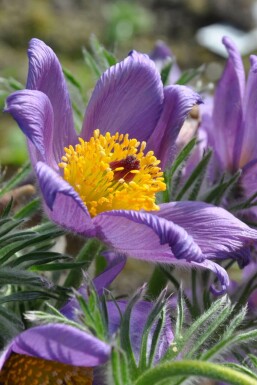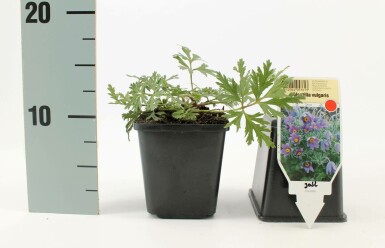

25cm



Welcome to the enchanting world of Pulsatilla, commonly known as pasqueflower, an exquisite genus that graces the European landscape with its delicate blooms. This charming plant is celebrated for its vibrant flowers, which can be found in an array of colors including purple, white, and red, each adding a touch of springtime splendor to your garden. The Pulsatilla boasts a lush, green foliage that complements its blooms, although it is not an evergreen and will lose its leaves in winter. This species, while not fruit-bearing or fragrant, is a perennial favorite among garden enthusiasts for its unique, feathery seed heads and its ability to thrive in a variety of soil types.


25cm





25cm





25cm



The Pulsatilla genus, commonly known as pasqueflower, is a delightful addition to any garden with its enchanting, bell-shaped flowers and soft, feathery seed heads. These perennials are celebrated for their early spring blooms, which appear in March through May, signaling the end of winter and the arrival of the warmer months.
Favored for their vibrant display of purple, white, and red flowers, pasqueflowers are ideal for creating a splash of color in borders, group plantings, and along edges. They are equally at home in pots and planters, offering versatility and charm to a variety of garden settings.
Pasqueflowers are distinguished by their clump-forming growth habit, reaching an ultimate height of approximately 25 cm. They boast a lush green foliage in spring and summer, which provides a rich backdrop to their spirited floral hues. While the plants are not evergreen, their foliage and striking flower colors in spring make them a standout feature during their active growth seasons.
These plants have an average water need and thrive in well-drained soils across all types. They are best situated in sunny to partially shaded locations, ensuring they receive the necessary light to flourish. Though they are not drought-resistant, pasqueflowers do not require excessive watering, making them fairly easy to care for.
In terms of propagation, Pulsatilla can be grown from seeds or by taking root cuttings in the latter part of the year. The genus is native to Europe and adapts well to similar climates, where they can be enjoyed in their natural, undisturbed form, as they require no pruning.
Embrace the serene beauty of the pasqueflower, a herald of spring with its enchanting blooms that grace the awakening garden. With delicate petals that dance in the breeze and a soft, silken foliage, these perennials offer a mesmerizing display that captures the essence of the season's renewal. Whether in pristine white, the classic wild form, or the rich hues of red, pasqueflowers are a poetic addition to any garden space, inviting contemplation and admiration from all who gaze upon them.
We would like to provide some tips on how to plant and care for a Pulsatilla. By following these tips, you can be sure to enjoy your Pulsatilla for a long time.
The ideal location for this species is one that receives full sun to partial shade, with a preference for the brighter conditions to encourage robust flowering. It is adaptable to a range of soil types, provided they are well-drained. The delicate and vibrant blooms of this plant are best showcased in garden borders, group plantings, or as edge accents. Additionally, its compact growth habit makes it suitable for container gardening. To ensure the plant's health and vigor, choose a spot that offers protection from harsh winds and extreme heat.
To ensure successful planting, select a location that receives full sun to partial shade and has well-drained soil. The versatile nature of Pulsatilla allows it to adapt to various soil types, though adequate drainage is crucial. When planting, space the clumps sufficiently apart to accommodate their mature size and clump-forming growth habit. Careful attention to watering is important; while Pulsatilla has average water needs, it is not drought resistant, thus regular monitoring and watering during dry spells will help maintain its health and vibrancy. With proper care, the plant will display its unique silver-grey fruit and colorful blooms come spring.
To ensure the Pulsatilla thrives, incorporating a balanced fertilization regimen is crucial. Begin the process by applying a light dressing of a balanced, granular fertilizer in early spring as new growth appears. This initial feeding will help establish a robust root system and support the early flowering period.
Given its moderate water requirements, ensure that the soil is not overly saturated after fertilizing, as this species prefers well-drained conditions. Additional feedings are generally not necessary; however, if the plant is grown in a container, consider a half-strength liquid fertilizer every four weeks during the growing season to compensate for the more limited nutrient reservoir available in potting soil.
Remember that the Pulsatilla is a relatively low-maintenance species, and over-fertilization can do more harm than good, potentially leading to excessive foliage at the expense of its characteristically vibrant blooms.
Pulsatilla, with its clump-forming growth habit, is an undemanding species that offers ease of care, particularly when it comes to pruning. This plant requires no pruning to maintain its health or shape. However, if desired, any dead or damaged foliage can be gently removed to keep the appearance tidy. This action also encourages new growth. It is best to perform this minimal upkeep after the blooming period has concluded, allowing the plant to focus its energy on the next season's display.
To maintain the health and vigor of Pulsatilla, ensure the soil remains moist but well-drained, particularly during its blooming period in the spring. While this species has average water needs, it is important to avoid overwatering, as this can lead to root issues. During the growing season, water the plant when the top layer of soil feels dry to the touch. As it is not drought-resistant, consistent moisture is key, especially during prolonged dry spells. However, once established, Pulsatilla can tolerate occasional short periods of dryness.
For those who cherish unique textures in their garden, the soft, hair-like foliage of Pulsatilla is a delightful feature. This plant's foliage remains attractive even when not in bloom, providing a visual interest throughout the growing season. It's also worth noting that Pulsatilla seeds are ornamental, with feathery tufts that catch the light beautifully. These seeds can contribute to the natural propagation of the species, ensuring a continuous display of its stunning, bell-shaped flowers year after year.
Discover the enchanting Pulsatilla, a plant that graces any garden with its delicate flowers and silken, feathery seed heads. This charming species thrives in well-drained soil, offering a delightful display of blooms in early spring that evolve into captivating seed pods, adding long-lasting visual interest to your outdoor sanctuary.
